Do you have a toddler who is ready to start doing chores? It’s never too early to start teaching children the importance of helping others, and chores are a great way to do that. When you start kids early (even at 2 or 3) on doing chores, they’ll be excited to be a big helper!
Not only do chores help children learn how to work together, but they also give children a sense of accomplishment. This is because children can see the tangible results of their hard work. Additionally, doing chores helps teach children the importance of families working together for a common goal.
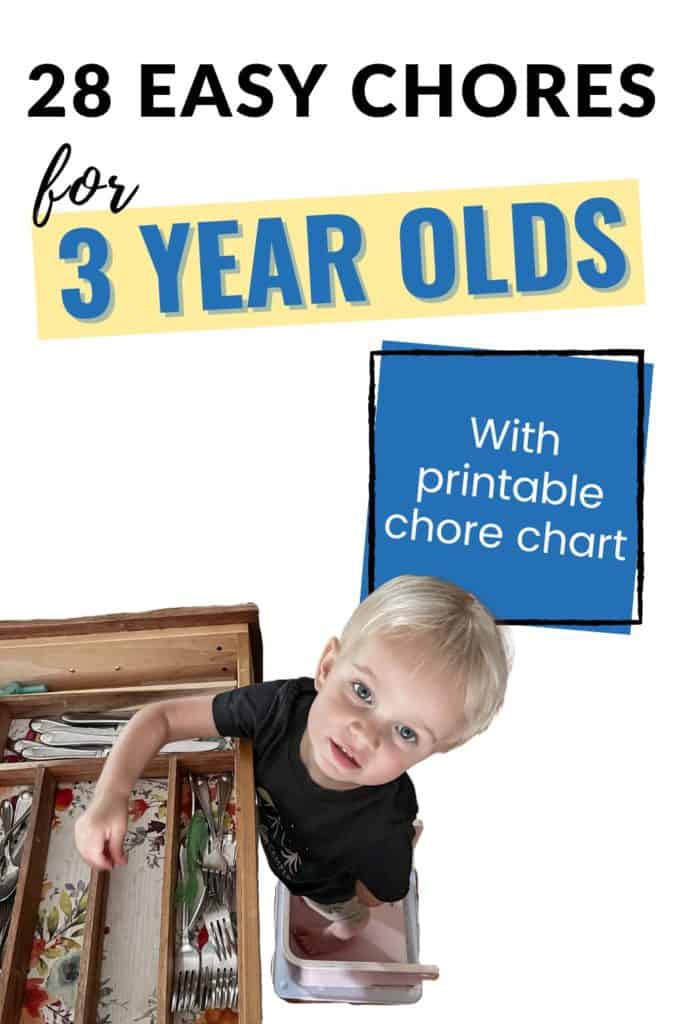
Disclosure: This article contains affiliate links. As an Amazon Associate I earn from qualifying purchases. You can read my full policy here.
While it’s great to give children chores that are within easy reach, that’s not always easy. A step stool can make a big difference in your child’s ability to do a chore. That’s why I’ve partnered with Little Partners to review their 3-in-1 Learning Booster seat and Step Stool. Read on to learn about some great chores for 3 year olds (plus how the booster seat / step stool combo can help).
Table of Contents
Chores for 3 year olds
While you may initially think that the list of chores a child could do is limited, there’s actually a ton of things your child can do around the house. The trick is, they’ll likely need guidance and supervision from you. Remember, you’re laying the groundwork now for them to actually be helpful later.
Cleaning and tidying chores for 3 year olds
- Put away your toys
- Put blocks away in swoop bag
- Help make your bed
- Pick up your clothes and put them in the hamper
- Put books on shelf
- Put trash in can
- Dust baseboards with a sock on their hand
- Use dust buster to vacuum small messes
- Sort recycling
Meal prep and kitchen chores for 3 year olds

- Clear your plate/bowl from the table
- Wipe down the table
- Wipe down booster seat after meals
- Set spoons / forks on the table for everyone
- Put away utensils from dishwasher
- Put away groceries
- Add ingredients to mixing bowl
- Stir batters or casserole ingredients
- Knead dough
- Sprinkle cheese or seasonings
- Spread butter or soft jam on bread
- Cut strawberries, soft cheeses, or avocado with plastic knife
Laundry chores for 3 year olds
- Help move laundry from washer to dryer
- Help match socks
- Put away clean clothes after folding
- Fold washcloths and hand towels
Hygiene / self-care chores for 3 year olds
- Choose clothing for the day
- Get dressed by yourself
- Brush your teeth
Can a 3 year old do chores?
Yes, 3 year olds (and even 2 year olds) can do chores. In fact, they should!
However, you may need to give your child a leg up to do their chores. For example, while my son can reach inside the utensil drawer when he’s putting away forks and spoons, he reaches up and can’t actually see inside the drawer. That means he just tosses forks into the drawer willy-nilly instead of arranging them by type.
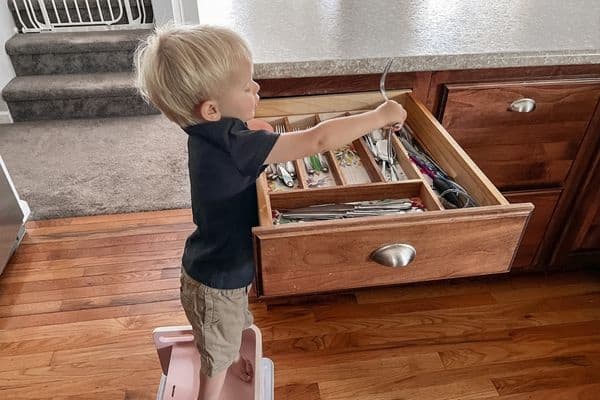
Little Partners’ 3-in-1 Booster Seat / Step Stool helps him by allowing him to actually see what he’s doing. That way, he’ll at least sort the utensils by type, even if they’re not perfectly stacked in the drawer.
With that said, you’ll need to adjust your expectations for how well the chores are done and how long they’ll take. Remember, the purpose of toddler chores isn’t so much about a clean home as much as it is to teach your child responsibility and instill a sense of cooperation.
For example, you could probably put your child’s clothes away after folding them easier and faster if you did it yourself. However, they won’t learn how to do it themselves that way. Plus, having your child put up their own clothes teaches them that their laundry isn’t done by a fairy; someone has to put in the work!
Chores will also take a lot longer with your 3 year old involved. For example, here’s what putting away some freshly folded shirts often looks like for us:
- I hand my son a pile of shirts. He toddles to his room, dropping a shirt or two as he goes.
- I open the drawer where his shirt goes.
- He tosses the shirts into the drawer and closes it, leaving them half sticking out of the drawer.
- I add hand him the shirts he dropped and he adds them to the drawer. I tuck them into the drawer better and close it once more.
- I tell him, “Good job! You must be so pleased with your work!” His smile is worth the hassle.
RELATED: Giving your child a growth mindset
And then we do this same process for pants. And socks. And undies. You get the idea.
Bottom line: You may not want to rely on your 3 year old’s “help” for multi-step chores if you’re trying to clean for guests. Instead, give them simple tasks like, “Throw away that piece of paper over there.”
But when you have time and are more focused on teaching your child (rather than making your drawers look KonMari perfect), that’s when you do chores with them.
Should kids have chores every day?
I try to have my kids (even the small ones) do at least one small task a day. After all, housework is a never-ending cycle, so it’s most helpful if they realize that you can’t leave everything alone for long without consequences.
That’s why we use our chore chart to keep everything going smoothly (Want one of your own that’s super easy to fill in and use? Grab it here).
At the same time, I understand that my kids sometimes have a lot going on. If we’ve had a big day or if they’ve been gone all day with their grandparents, I may not push for them to do much that day.
How many chores should a 3 year old do per day?
Of course, children need to get dressed and brush their teeth daily (and the Learning Booster/Step Stool can help with that), but they also should do brief daily chores. Each chore should only be about 5-7 minutes long, and they should be spaced throughout the day. Perhaps they could make their bed in the morning, help you make lunch, then put away toys before dinner.
And then, your child’s Learning Booster can quickly wiped down and easily be set up for meal time (with the seat flipped to the best height for them).
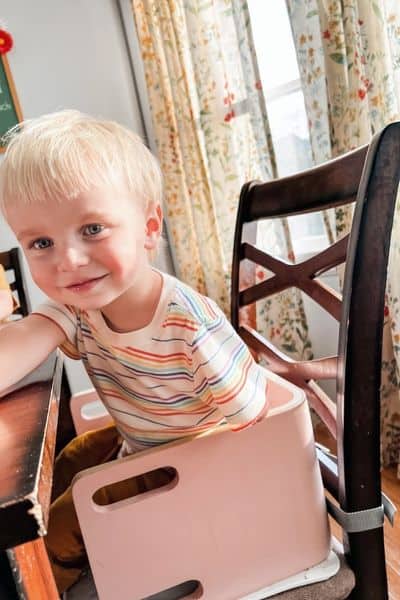
With the way that the 3-in-1 Learning Booster Seat is made (all wood, non-toxic paints, and a simple vinyl seat pad without a million little crevices), one of your child’s chores could be to clean their own seat after meals.
Tips for getting 3 year olds to do chores
While toddlers often enjoy chores, they may be resistant to starting (or get distracted along the way). Here are some ways you can make it easier.
Use a family chore chart. I know, there’s lots of chore charts for toddlers out there. But in my opinion, it’s a better lesson to show your child that the whole family works together. Grab my customizable family chore chart for an easy printable that fits your family.
RELATED: Weekly family chore chart printable
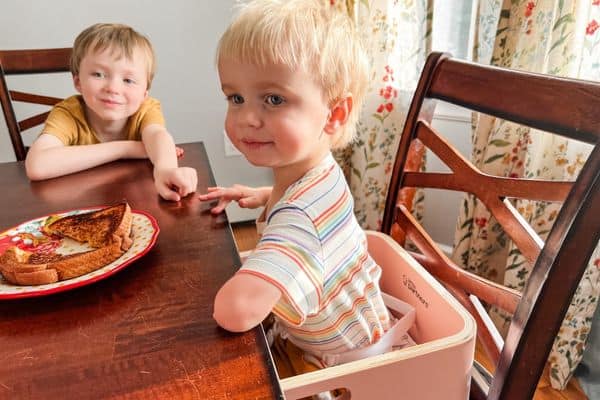
Don’t try to do chores when your child is hungry or tired. After all, how well has that ever worked for you? Instead, get your little one a healthy snack (while they’re sitting in their 3-in-1 Booster Seat), a nap or some quiet time, and then try for chores.
Be aware of your toddler’s attention span. While they may initially be excited to help you move their toys out of your room (How do they always migrate to there anyways?), it won’t take long before you realize your little helper has wandered off and is now playing with their race cars instead of dropping them off in the play room.
Make it fun. Sing songs, pretend you’re rescuing stuffed animals from a bad guy, or that picking up all the socks will defeat a monster. No matter how you do it, play will make your child more willing to cooperate (and you’ll both be happier).
RELATED: Playful parenting to get kids to listen
Don’t interrupt deep play for chores. This might be an unpopular opinion, but hear me out. Your child’s primary developmental job is to play. If they’re engrossed in building a tower or playing with stuffed animals, that’s the best thing they could be doing. Try to sneak away and see what you can accomplish while they’re still playing by themselves.
Have less stuff set out. For example, instead of having every single toy in your home shoved into a toy chest, only have a few out at a time, and arrange them neatly on shelves. This makes it less likely that your toddler (or you!) will melt down in a puddle of overwhelm over all the clean-up that’s required.
RELATED: Easy toy rotation system your kids will love
Give them the right tools for the job. Adult-sized brooms will be hard for your toddler to control and may lead to your lamp getting knocked over by the handle! Instead, opt for child sized hand brooms or even a little Dust Buster vacuum.
And remember that many surfaces, especially in the kitchen, are too tall for your little one to reach. That’s why a step stool like the Little Partners 3-in-1 Booster Seat is so helpful. Even for years after your child no longer needs a booster seat for the table, this versatile product is perfect for a step up. Plus, the included silicone mat keeps it non-slip so your child stays safe.
(Need something a little taller than the booster seat alone? Check out my review of the Little Partners Learning Tower, which is easily adjusted to 4 heights and has guardrails to keep your child safe).
RELATED: The best learning tower for your toddler
Conclusions on chores for 3 year olds
So, if you’re looking for some ways to get started with teaching your child how to help around the house, try these chores. Remember, it may take a little bit of guidance and supervision from you at first, but eventually they will be able to do these things on their own (with maybe a little reminding now and then).
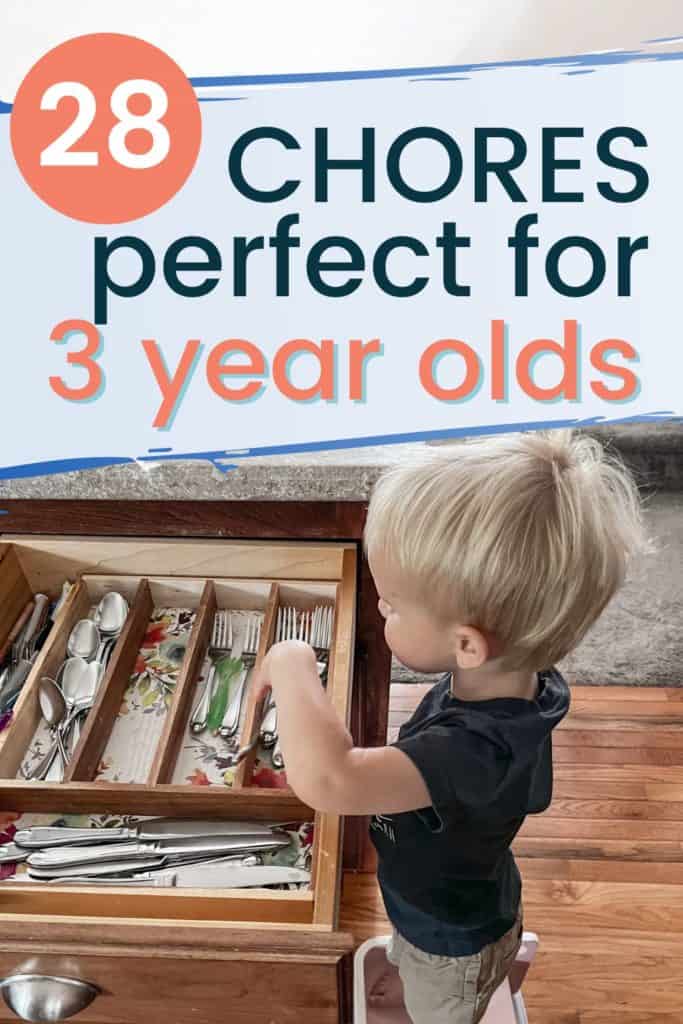
Try these chores with your 3 year old and let us know what you think. Remember, the more tasks they can do on their own, the less work you’ll have to do in the long run. And that’s definitely something to celebrate.
